
VOL. II NO. 36 REG NO. L5015 DELHI, THURSDAY MAY 18, 1944
|
TO AID STILWELL FORCES
ALLIES SWEEP BELOW MALAKAWNG
IN MOGAUNG VALLEY ACTION
There seemed but one avenue of escape left for the badly mauled remnants of the Japanese 18th Division in the Mogaung Valley this week - and that was hari-kari.
Adding to the Japs' plight, a new drive was opened upon their Kamaing-Mogaing-Myitkyina triangle from the east this week when strong Chinese forces swept across the Salween River at several points along a 100-miles front in an effort to link up with Lt. Gen. Joseph W. Stilwell's Chinese-American troops now hammering insistently upon the gates of Kamaing from the north.
This assault from Western Yunnan Province, plus the southward push of Stilwell's infantry and tanks, plus the stranglehold clamped by the Chindits upon the enemy's lines of communication below the triangle, does not portend immediate collapse for the Japanese. But it further weakens the already precarious enemy situation and should do much to hasten ultimate victory by the Allies.
14TH A.F. SUPPORT
The new offensive, according to the Roundup's as yet sketchy reports, is being strongly supported by the 14th Air Force, which is busy ripping Strategic Jap points in Western Yunnan and along the Burma-Thailand border.
Meanwhile, the 22nd and 38th Chinese Divisions in the Mogaung Valley continue to forge southward thusly against bitter resistance:
1 - Malakawng two miles below Inkangatawng along the main valley road, is now surrounded, following a furious tank and infantry attack, and its fall appears imminent.
2 - East of the road, the main force of Chinese occupied Hlagyi, moved southward down the trail past Hkatangkawng, Samlan and Tarongyang and effected junction with the spearhead unit which two weeks ago seized Manpin and has held it against several counter-attacks. Manpin is only nine miles above Kamaing.
3 - And in the mountainous terrain along the eastern rim of the valley, other Chinese units consolidated positions around Auche and are now reducing a pocket of resistance at Warong.
TANK, PLANE HELP
The action which carried Chinese infantry behind Malakawng was viciously preceded by General Sherman tanks and Mustang dive-bombers. The tanks blasted their way through Jap lines to four and five miles beyond and swapped punches with artillery positions for four hours until they ran out of ammunition. According to offcial estimates, the American and Chinese-manned tanks inflicted 120 casualties and knocked out several anti-tank guns in the hit-and-run attack. Four tanks were lost, but their crews escaped.
A sweeping movement by nightfall carried the Chinese infantry south of Malakawng, following this preparatory hammering by tanks and aircraft of the enemy positions.
Beyond Malakawng, the Japs are still resisting bitterly, but the Chinese infantry has given them no let-up and in several sharpt actions has inflicted casualties. The advance is three miles below Malakawng, which places our forces 13 miles above Kamaing in this sector.
The most savage enemy effort to retake Manpin resulted in rout. Forty-five Jap bodies were left on the battlefield, including three officers - machine gun and rifle company commanders and a platoon leader.
The enemy is fighting a cunning, patient, delaying action usually keeping his 150mm guns silent while our aircraft are in the vicinity. Indeed, location of the Jap guns has been a major problem of recent fighting, Which illustrates the limitations of air mastery in such country against foes like the Japs, described by an American colonel as "slick little sons of bitches."
Interlaced with streams too wide for tanks to cross readily, but deep enough, with its jungle cover, to afford admirable sites for Jap artillery, the flat floor of the valley below Malakawng is an admirable defense sector.
It is possible that the enemy in the pocket have been virtually abandoned to fight a last-ditch stand, without hope of reinforcement. While the 18th Division is in sorry shape, it is still fighting fanatically with terrific artillery support, which is responsible for three times as many of our casualties as its light weapons.
Heavy rains have already fallen behind the Kamiang-Myitkyina front, in the Hukawng Valley and the Naga Hills. Monsoon showers, however, have been less appreciable in the Mogaung and Upper Irrawaddy Valleys. There it is comparitively dry and may remain so for several weeks. In any case, the inevitable rains will make the fighting more difficult but may not, according to an article written from the Mogaung Valley by Till Durden, of the New York Times, halt military operations for Stilwell's forces.
On the west flank of the Stilwell operation, Chinese troops continue to hold Mansum, while in the Fort Hertz Valley the Kachin Levies and Gurkhas are successfully following their harassing tactics against the Japanese.
|
Leadership of the CBI Air Service Command this week passed from the hands of Brig. Gen. Robert C. Oliver to those of Maj. Gen. Thomas J. Hanley, Jr., pioneer Army airman and recently commanding general of the Army Air Forces, Southeast Training Center.
Oliver, who arrived in CBI-land over two years ago with the first Air Corps contingents, is returning to the United States to a new assignment.
A West Point graduate in 1915, Hanley was transferred in 1917 from the Infantry to the Aviation Section, Signal Corps and emerged from World War I as a lieutenant colonel.
From 1939 to 1941, Hanley was a member of the General Staff Corps as G-3, Puerto Rican Department, and for three months prior to Pearl Harbor was a member of the Air Staff.
He brings to the Air Service Command a wealth of experience and knowledge. He was a graduate of the Air Service Field Officers' School in 1921, the Army Industrial College in 1925 and the Command and General Staff School in 1930. He is a command pilot, combat observer and technical observer.
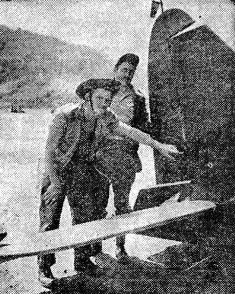 S/Sgt. Bill Christain and Maj. Richard Boebel point to ground fire bullet holes.
S/Sgt. Bill Christain and Maj. Richard Boebel point to ground fire bullet holes.
|
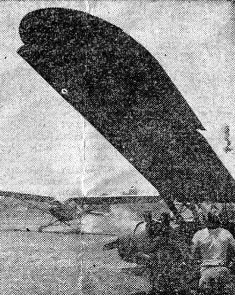 An L-1 lands with a broken strut to join the light plane casualty in foreground.
An L-1 lands with a broken strut to join the light plane casualty in foreground.
|
Hopping from one jungle airstrip to another in the shifting pattern of warfare with the Chindits deep behind Jap lines in Burma, a unique American aerial unit is carving itself a niche in CBI-land's singular history. This is the light plane section of Col. Philip Cochran's Air Commandos, now operating from incongruously-named "Peaceful Valley." From their various bases, the staff sergeant pilots of the Stinson L-1's have, among other missions, evacuated almost 1,000 casualties from the jungle, conducted reconnaissance flights, transported key officers and flown-in medicines, ammunition and mail. The highly-maneuverable craft are a forceful morale factor because they assure the wounded a chance for survival. As one of the veterans of the first Wingate Expedition of 1943 declared, "Christ, they look like angels to us." Plagued by mortars, Zeros and small arms fire, plus tight landing and takeoff space, the saucy L-1's have continued their multipilicity of tasks. Lean, dark Lt. Col. Clinton Gaty, of La Jolla, Calif., who likes to "buzz" Jap positions, is the unit's C.O. His men live in tents and hammocks under clumps of bamboo, eat at a mess hall run by a British corporal, entertain themselves by a radio receiver salvaged from a C-47, and once had to dive into slit trenches 18 times in a day. When these pictures were taken (By Bill Vandivert of Time, LIFE and Fortune), some of the pilots were nearing 150 missions, each one loaded with danger. Vandivert met a polyglot group: A farmer, a bartender, a sandhog in a Chicago tunnel, a troubleshooter for an oil company, a theater usher, a life insurance sales manager. Brushes with death and escapes from capture are so numerous as to be commonplace. It's not a case of looking for trouble, it finds the light plane pilot every time he takes off on a mission.
 Walking casualties sit behind a paddy bund watching a takeoff. Their turn came later. There were 35 wounded to fly
out in this one operation.
Walking casualties sit behind a paddy bund watching a takeoff. Their turn came later. There were 35 wounded to fly
out in this one operation.
|
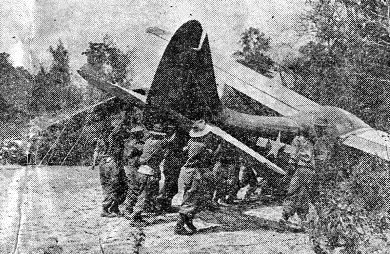 West African troops drag crashed ships into the underbrush. They camouflaged them, intend later to burn them when
the time comes to evacuate the area.
West African troops drag crashed ships into the underbrush. They camouflaged them, intend later to burn them when
the time comes to evacuate the area.
|
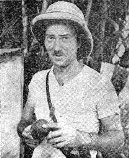 S/Sgt. Jesse Webster displays fruit he picked out of an aileron after a tight take-off.
S/Sgt. Jesse Webster displays fruit he picked out of an aileron after a tight take-off.
|
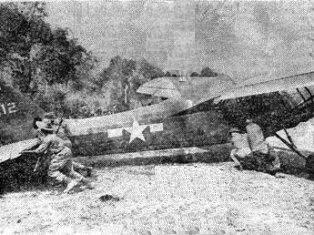 Wingate's Raiders haul a light plane back to the very edge of the jungle runway for a
take-off from a strip behind Jap lines.
Wingate's Raiders haul a light plane back to the very edge of the jungle runway for a
take-off from a strip behind Jap lines.
|
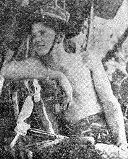 Pfc. C. A. Christain killed three Japs protecting one of the saucy L-1's bases.
Pfc. C. A. Christain killed three Japs protecting one of the saucy L-1's bases.
|
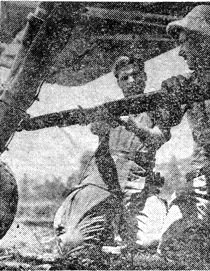 S/Sgt. Lloyd Samp, right, and S/Sgt. Jesse Webster put bamboo splint on a strut.
S/Sgt. Lloyd Samp, right, and S/Sgt. Jesse Webster put bamboo splint on a strut.
|
 Plane uses every inch of the runway to clear field while loaded with casualties.
Plane uses every inch of the runway to clear field while loaded with casualties.
|
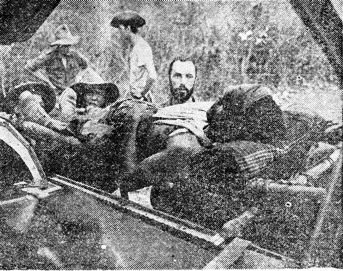 A Gurkha casualty is loaded into a plane for evacuation. The L-1 takes two stretcher cases, plus one sitting wounded.
A Gurkha casualty is loaded into a plane for evacuation. The L-1 takes two stretcher cases, plus one sitting wounded.
|
YANKS BREAK RAIL RECORD; BROTHER ACT
T/Sgt. J. L. Beasley is one of those low characters who plays "dead dog" and then, when you least expect it, nips you figuratively in the ankle.
This fellow Beasley, assigned to a train operating battalion, read the Roundup's stories on brothers it had uncovered in the Theater and he didn't say a word until now.
Rather, he bided his time, and finally this week he lettered us as follows: "I have patiently waited until each organization had shot its bolt and made its boast and frankly they are but weak burps alongside the real thing.
"In this battalion there are four sets of brothers."
With which, Beasely named himself and his brother, James; Bernard and William Hackett, who are not only brother, but twins; James and Gerald Murphy and Don and Jim Egan.
Meanwhile, it was reported this week that American railroad troops have increased the capacity of the Bengal and Assam Railway approximately 40 percent since taking over the operation of this vital link in the Assam line of communications two months ago.
Operating under Brig. Gen. T. B. Wilson, forman chairman of the board of TWA, these specially-trained former U.S. railroaders have brought American operating methods to the Far East.
The line is a meter gauge single track road branching off the broad gauge railway which runs out of Calcutta. Over its narrow tracks flow the major portion of the supplies which are sent toward the Ledo Road into Northern Burma for lt. Gen. Joseph W. Stilwell's Chinese-American troops which are battling the Japs in the Burma jungles.
In spite of perverse conditions and proximity to the front lines near the Kohima breakthrough area, the railroad has shown a steady increase in capacity since American control went into effect on March 1.
|
Created From Junk Pile By Former Minister
By SGT. EARL LANGENBAHN
APO 629 (Chabua, India) - Having seen and read about various types of G.I. barber chairs rigged out of junk piles, this Air Service Command base would like to submit a creation recently designed by Cpl. Russell S. Schow, former minister of Lehi, Utah, who is the squadron tonsorial artist in his spare time.
Although not having previous experience in the noggin-trimming department. Schow fell into the groove like a past master in shaping the hirsute head adornment of his fellow khakiclads.
Falling heir to a pair of clippers, comb and a broken-down box type chair, Schow set about his venture in earnest. With an eye to the future, he followed the motto, "Modernize, don't apologize," and a new idea was born.
Going to the salvage yard, which is invariably the haven of all prospective inventors, he found the answer to his primary question: How to elevate and lower the chair. There on the top of the heap he found an actuating strut of a P-40.
Little did the Japs know how useful they would be when they burnt up a tail wheel jack in one of their recent visits here. This he used for the base. The actuating cylinder and jack were then placed in an upright and rigid position with the use of braces fashioned from the flying wires of a P-T 16 that was "ditched" in a forced landing. Looking farther, he found an old hand pump belonging to a P-43, and a vapor eliminator chamber. A few scrap fittings and bolts and the chair began to take shape.
From the machine shop he enlisted the services of Sgt. Paul M. Weaver, of Fresno, Calif., to assemble the complicated hydraulic lines that carry the pressure to the strut, and the valve that releases it to low pressure. A complex bolt which attaches the chair to the cylinder was then machined by M/Sgt. Lou Loftin of Houston, Tex., and the project was finished.
The fellows with the "five o'clock shadow" suggest that he hinge the back so it will be suitable for shaving but Schow says that for the present it will have to remain an up-and-down, one-way seat.
|
MIGHTY MITES OF CBI-LAND
When the Roundup innocently published a story that S/Sgt. Robert Kessler was the smallest man in the AAF at five feet, two and three-quarter inches, a CBI bomber squadron wrote in and put up as their personal candidate S/Sgt. Allen D. Query, five feet, two and a half inches.
The Roundup printed this claim and was ready to concede the title to the bomber boys.
But recent mail brings news of three more men, all of whom measure less than Query.
The first communication came from Lt. Roy Young in China. Young says his squadron has a candidate who measures only five feet, one and a half inches tall. He is Sgt. Alphonse J. Godbout, who is an airplane mechanic.
The Roundup was ready to crown the new champ in eight point type when the ATC entered the picture with a claim for S/Sgt. Raymond Mitchell at APO 467 (Sookerating, India), who hits the tape at only five feet, one and one half inches.
It looked like the tossup between the ATC and the China fighter squadron when ATC rang the bell with a guy who the Roundup positively backs as the smallest G.I. in the Theater. He is Pvt. W. B. LaBrosse, also of APO 467, who stands exactly five feet, three-quarter inches.
If we're wrong this time, we'll write our Congressman and have the draft boards reclassified.
PATIENCE REWARDED
EQUIPMENT ARRIVES, TWO YEARS LATER By S/Sgt. HARRY A. SKVIRSKY
INDIAN OCEAN PORT - The patience of a Signal Corps supply unit was partially rewarded here the other day when organizational equipment, including a field safe, a set of antiquated AR's, field manuals and other official papers, arrived on the local scene.
Their appearance was slightly delayed - the unit departed the sheltering shores of Shangri-La in May, 1942.
Before the war ends, M/Sgt. George P. Smith, of Conyers, Ga., hopes to see a three-quarter ton carry-all truck which was crated for overseas shipment, but has yet to be disgorged from a ship.
Swampy Trails Now Truck Roads
By GEOFFREY TEBBUTT Melbourne Morning Herald
WITH STILWELL'S FORCES, MOGAUNG VALLEY - (Delayed) - Rough tracks through swampy jungles along which the Japanese retreated are rapidly becoming wide roads for truck fleets pounding down from Assam. Bulldozers, large and small, are transforming this lonely countryside, hacking out landing strips for the mosquito squadrons of two-seater communications aircraft based continuously closer to the fighting line or dropping strips over which Douglas transports are heaving out cushioned sacks or delivering more delicate supplies by parachute.
Some groups of Kachin villagers, through whose country war has swept, wait about these strips to gather damaged cans of food or pieces of parachutes for clothes, but one sees much of these quaint native people from the tall tangled timber. The Chinese, who predominate in the Mogaung sector, and the spectacle of Chinese, Americans and Negroes swimming and washing clothes together in creeks behind the line partially illustrate the cosmopolitan character of Lt. Gen. Joseph W. Stilwell's command. The problems of liaison and administration are constant, and it is amazing how much has been achieved.
The Chinese, who have adopted mechanized warfare well enough to manage tanks, sometimes cling to their peasant superstitions on questions of medicine. An American doctor, who is with a Chinese tank formation, was telling me of one who ran over a 25-foor python and preserved it in alcohol. They said they wouldn't need the medical outfit any longer as the python would specify against all complaints.
Chinese medical orderlies are given as much training as conditions permit but their methods are a constant source of awe and anxiety to the Western physicians. Evidently they work - and patients expect them to work - on the principle of administering as many drugs as possible, as the question of prestige is involved therein.
Fortunately, the Chinese are hardy in these inaccessible areas and have been fattened on the abundant food which characterizes the American Quartermastering operations.
EAC BOMBING SETS RECORD DURING APRIL
EAC HQS. - The Third Tactical Air Force announced this week that April marked its biggest month against Japan since this force was first organized in the CBI.
The combined USAAF-RAF force dropped 2,476 tons of bombs. Rivercraft destroyed were 197, with 550 damaged; launches destroyed were 12, with 29 damaged; motor vehicles destroyed were 129, with 254 damaged; locomotives destroyed were five, with 50 damaged; and 12 rolling stock were destroyed, with 167 damaged.
Brig. Gen. George F. Egan's Northern Air Sector Force carried out 1,710 sorties in support of Lt. Gen. Joseph W. Stilwell's drive down the Mogaung Valley.
Another tactical unit, under Col. Philip Cochran, logged 580 sorties in providing an air umbrella for Maj. Gen. Joe Lentaigne's Chindits in Burma.
ICW-ATC OPEN FIFTH OF LINE MESS HALLS
ICW-ATC BASE - The fifth in a series of line mess halls at ATC stations was opened recently in Assam.
The line mess halls were started by Capt. H. S. Lokey, ICW-ATC mess officer. These halls, which are open 24 hours daily, prevent a tie-up of transportation facilities.
BURMA BANSHEES GET MEDALS FOR HEROISM
UPPER ASSAM - Brig. Gen. John F. Egan recently presented a Silver Star, 39 Distinguished Flying Crosses, 27 Air Medals and four Oak Leaf Clusters to Air Medals to the pilots of Lt. Col. Albert L. Evans, Jr. Blank Fighter Group for extraordinary aerial achievement.
Known as the Burma Banshees, this group has been supporting the ground forces of Lt. Gen. Joseph W. Stilwell in their advance through Northern Burma. Egan, in his presentation address, congratulated them on their enviable record.
Award of the Silver Star for gallantry in action was presented to Lt. James F. May, Jr. He singly attacked an enemy formation of 24 bombers and 35 fighters, destroying one bomber, before enemy action forced him to bail out. His attack affected the bombing accuracy of the enemy, breaking up their formation and causing some aircraft to release their bombs before getting over the target.
The awards were as follows:-
SILVER STAR, DFC - Lt. James F. May, Jr.
DFC, OAK LEAF (AM) - Maj. George B. Hamilton, Maj. W. S. Harrell, Lt. R. D. Bell, Lt. Wayne K. Snyder.
DFC - Lt. Col. Albert L. Evans, Jr., Col. I. W. McElroy, Maj. Stanton T. Smith, Jr., Capts. Maurice J. Cleary, R. J. Becker, O. R. Alfred, G. P. Haviland, J. H. Darden, E. B. McMillen, L. F. Upson, Jr., C. G. Whitley, Lts. S. M. Brand, C. F. Heil, M. A. Marx, Jr., P. H. Randall, G. F. Schlagel, C. H. Curtis, G. E. Sparling, P. R. Adair, L. T. Chapman, P. A. Coil, S. Dare, J. M. Matulevicz, R. L. McCarty, R. B. McReynolds, E. C. O'Connor.
DFC, AM - Lts. R. L. Burns, R. N. Gale, J. S. Grinnan, W. F. Hicks, W. W. Masten, W. C. Nall, J. P. Smith and R. A. Witort.
AM - Capts. J. F. Daino, R. E. Frey, B. G. McClintock, J. M. Roberts, R. E. Ward, Jr., Lts. R. R. Anderson, Jr., J. A. Rockwell, C. J. Baldwin, T. N. Jewell, A. Freeman, J. A. Hartswick, B. G. Bell, H. C. Cherry, Jr., J. R. Cook, E. F. Johnson, D. C. Roane, J. W. Wright, Jr., and J. Wilson.
CBI PLANES HOLD BIG EDGE OVER NIPS
14TH AF CREDITED WITH 541 VICTORIES
WASHINGTON - (UP-ANS) - Secretary of War Henry Stimson revealed this week that since the start of the war the 10th Air Force in India has bagged 282 planes, while losing 98 of its own, while the 14th Air Force in China has downed 541 Nips against the loss of 153.
The overall figure since the war started against Japan shows American Army, Navy and Marine fliers have destroyed at least 9,203 Nip aircraft against the loss of 2,335 of their own.
Stimson also said that America's new ace of aces, Maj. Richard Bong, who has shot down 27 enemy planes, came home to learn to shoot. Bong told Stimson that if he had learned deflection firing he would have 75 planes to his credit.

|
Red Caps
ATC INSTITUTES SERVICE
ASSAM ATC BASE - A sign hanging in front of a bamboo basha near the billeting office boasts, "The only Red Cap service in India." Under it sit the porters whose job it is to handle the luggage of incoming passengers.
The "red caps," garbed in snappy outfits, are now a familiar sight to the many celebrities, as well as to the common garden variety G.I.'s who have rolled up to the billeting office on a truck after the transport plane has reached its objective.
Hankering to bring a little bit of New York to India, Lt. Col. C. F. Cusack, India-China Wing service officer for the ATC, got his head together with Capt. H. S. Lokey, now Wing mess officer. They hatched the idea of instituting the red cap service. They instructed the post tailor to get busy and make shorts and short-sleeved shirts of bright blue material, trimmed with gold, and to top off the uniform with a brilliant-red, pill-box style cap.
Porter service offered by the uniformed Indian red caps has been sufficiently unique to evoke favorable comment from such cinema celebrities as Joe E. Brown and Paulette Goddard and from military bigwigs who have been billeted at the station prior to jumping The Hump to China.
Nine red caps work three to each eight-hour shift, furnishing 'round-the-clock service to arriving passengers.
SEAC ANNOUNCES DRIVE FROM INDIA
NEW DELHI - A powerful Allied offensive to erase the Japanese invasion threat to India is proceeding on every front, said a SEAC communique this week, as British troops continued to smash Jap positions around Kohima.
It was also announced that the Japs have lost 6,000 men around the Imphal Plain and 3,000 in the British counter-offensive around Kohima.
The Nips are now using night fighters in an attempt to cut off Allied reinforcements to the Chindits inside Burma, it was revealed. The Chindits are still holding their road blocks inside Burma.
AIR SUPPORT INCREASES
The Allies have been stepping up the tempo of their air support. Over 200 bomb tons were dropped at Ningthoukhong in a two-day blitz. As a result of this, 14th Army troops were able to consolidate their positions along the Tiddim Road.
According to the Associated Press of India, the Japs have scattered their forces from across the Chindwin to a depth of 50 miles and a length of about 250 miles, stretching from Kohima in the north to Tiddim in the south.
The Japs are also in a hoop-like position around the Imphal Plain, being southwest of Imphal along the Silchar-Bishenpore track, to complete isolation of the Manipur capital.
JAPS ON SPOT
But their position has fallen off from its threatening aspect of three weeks ago. At one time, the Nips were within 15 miles of Dimapur, on the vital Bengal-Assam Railway line. Now the entire west Naga Hills area has been cleared of the enemy and they are being driven out of the Kohima area.
Imphal is still surrounded, but the Japs have not ventured an attack on the level Impahal Plain, being content to hold their hill positions.
Mustangs
SCORE SHUTOUT OVER JAPS' ZEROS
EAC HQ. - An American squadron of P-51 Mustangs this week knocked 13 of 25 Japanese fighters out of the air, got two probables and damaged six others without loss to itself.
This long-range fighter-bomber squadron now boasts 39 enemy aircraft to iuts credit, with several probables and many more damaged.
One squadron was led by Maj. S. M. Newcombe, former Drew University student and native of Green Village, N.J. He described the sky slaughter thusly:
ENEMY SPOTTED
"We reached the Irrawaddy River and went onto Meiktila airfield. We gradually reduced height to 16,000 feet. No Japanese planes were visible, so we went on to Aungbun, where I saw two enemy planes in the air. I delegated a section to drop its long-range tanks and attack, but quickly realized the Japs were there in force."
"There were about 29 of them," he continued. "They were all flying close together. The whole squadron then went in to attack them. I noticed the Japs were of pretty good caliber and showed a tendency to fly in formations of two and four, presumably for protection. I dived out of the sun onto the tail of two of them, and gave one of them a short burst at 20 yards.
DOUBLE VICTORS
"The enemy plane seemed to belch flame out of its engine and cockpit, and explosions shook its wing roots. It seemed to me the skill of the Jap pilots was very poor. Not one of my boys got a scratch."
Lt. Kenneth Granger, of Poland, O., bagged two Nips, as did Lt. R. F. Mulhollen, of Chicago, Ill.
Capt. J. J. England, of Jackson, Tenn., also smacked down two of the enemy, but he got the second one in self defense. He was leaving the target area after shooting down one Nip when four others jumped him.
"I made a shallow turn to draw one of them away from the formation," he said. "The move was successful. I got a burst into his cockpit. He flipped over on his back and, as he dived down, he blew up."
Religious Airmen
ICW-ATC AT TOP
No one can say whether soldiers in the India-China Wing of the Air Transport Command are better boys, or have better Chaplains, than the average in the Armed Forces, but at least they're more church-going.
Figures just compiled by the Wing Chaplain's office reveal that 311 out of every 1,000 men in the ICW-ATC attended some worship service each week during the first three months of 1944. This figure compares with the 113 per 1,000 who worshipped in the entire Army, navy and Marine Corps.
The latter tally is the latest released by the office of the Chief of Chaplains, Washington, D.C. The Wing Chaplains lay the nearly 300 percent better showing of the ICW-ATC to the "probable lack of distractions."
'MISSING FLYER' CALLS UP MOTHER
SENDS BEER LABELS TO CHINA BUDDIES
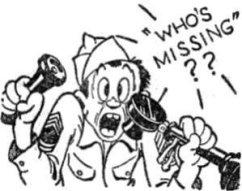
|
EAGLE SQUADRON, CHINA - When T/Sgt. Douglas A. Bell, bombardier of a medium bombardment squadron here, went back to Shangri-La after completing his required amount of combat hours he knew it would be a surprise to his mother - but he didn't know what a surprise.
When he arrived in Miami he called his mother in Mobile, Ala. It was five minutes before she could even say "hello." It seemed that she had received a notice from the War Department only the week before telling her that her son was missing in action in China.
(Bell had been missing in China. But he got safely back to his base.)
This was on April 7, which also happened to be his birthday. When he reported to Headquarters the eve of the same day, he was given orders promoting him to tech sergeant, and other orders which sent him back to Shangri-La. Which makes April 7 his day of the year.
For the information of all of his friends in China, he says in a letter that the blondes and heat in Miami are terrific. He also enclosed two Budweiser labels. The last touch was, of course, highly appreciated.
ENGINEER PRAISES LEDO ROADSTERS IN U.S. RADIO BROADCAST
WASHINGTON - The nation heard Lt. Col. George H. Taylor, of the U.S. Army Engineers, praise the construction of the Ledo Road behind Lt. Gen. Joseph W. Stilwell's Chinese-American forces. Just returned from Burma, Taylor radiocast, in part, the following observations:
"The Ledo Road is one of the most difficult engineering jobs ever undertaken, worse even than the Alcan Highway across Canada and Alaska. Mountains, jungles, humidity, heat, rains, insects - to say nothing ot the Japanese - all are pulling against Engineer units working on the road. Nevertheless, I found it progressing exceptionally fast.
"The Engineers, in fact, practically merge with the combat troops as the bulldozers move right in where the mortars were. And the Japanese don't overlook the Engineers when shooting.
"The terrible Burma monsoons are about beginning now. Naturally they will mean knee-deep mud and road washouts, hindering progress temporarily. But as the Chief of Engineers, Maj. Gen. Eugene Rybold, recently said: 'Victory seems to favor the side with the greater ability to move dirt.' I found our side moving plenty of dirt and plenty of Japanese along with it."
'Hi Stinky' OKAY IN CHINA
CHINA - Up here in China is one place where you can call your commanding officder a name and get away with it. That is - if you're a radio man.
Standing around a radio shack at operations you might hear a Peefcee give an order like this, "Come on in, Stinky. All clear."
Every pilot has his own name, among them, "Scarface," "Stinky," "Yeng Weh Wah" ("Young Baby Face") and others.
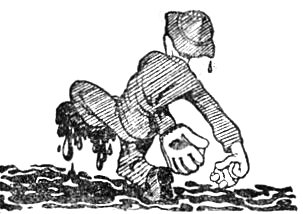
|
PEOPLE YOU MEET IN BURMA
Baseball Scouts Tipped Off On 'Bush' Pitcher
By BILL BONI Associated Press Correspondent
HUKAWNG VALLEY - People you meet:
He must have been a pretty fair country pitcher in Muny baseball around Buffalo, N.Y. We were sitting around the operations tent - actually just a couple of shelter halves stuck up on poles, with a field telephone lying on the ground - at an air strip in the Hukawng Valley in Burma, waiting to fly out on an inspection trip of the situation here in Assam, as it was affected by the Jap thrusts in Manipur.
His plane, a C-47 from a Troop Carrier squadron, had come in and dropped its cargo, then taxied to the head of the strip and poised for the takeoff. Just then one of the engines sputtered. They raced it, and again it spit and coughed. They did that three or four times more. Finally, they taxied back from the end of the strip, parked the plane and cut the engines.
A couple of us were whiling away the time with a baseball, a couple of gloves and an Ernie Lombardi catcher's mitt. He watched us for a while, then joined in. For some reason, I was the catcher. Two or three warmup tosses, and he was laying them in right where I asked for them.
(Editor's Note - Boni, before war reporting, was a syndicated sports writer.)
"Been four years since I did any pitching," he said, after another palpable strike had smacked home into the pocket.
Anybody wants a good looking pitcher, he's right out here somewhere. Name's Lt. P. T. Lauth, in case the Yankees want to send a scout this far.
"You all field officers?" he wanted to know. We said we were newspapermen.
"Well ah declare," he said. "All my forty-six years ah never met a newspaperman. Ah'd like to shake youh hand." And he did just that with all of us. He's a T/5 in a Quartermaster Company, and this is his second war - "18 months in France the last time."
His name is Davis, and his home is in Nashville, Tenn., and the last time he was in his home State he was doing some night club entertaining in the western part of Tennessee.
"Doctuh says it ain't good foh me but Ah kin still dance," he said. "Sure would like to get home though - got a niece dancin' in the Cotton Club in New York. Ah taught her - started her out with piano an's singin' - and Ah sure would like to see her. Been here 16 months, anyhow. reckon it's about time. Ah was gettin' home."
Lt. James H. Cloyd was the pilot, with Lt. Alfred T. Borbe as his co-pilot. It was Cloyd who finally set her down on the long concrete strip, and even the crew chief had to admit that, barring one slight bounce, it was a smooth landing.
THREE G.I.'S IMPROVISE MECHANICAL DHOBI WALLAH
|
By Sgt. EARL R. LANGENBAHN
UPPER ASSAM - "We send back everything but the dirt" is the motto of our unique G.I. laundry at this ASC service squadron.
Owned and operated by Cpl. Clifford H. Styack, of Joliet, Ill., and Pvts. Leland J. Feller, of El Paso, Tex., and Henry Mahle, of Philadelphia, it has proven well worth the effort of salvaging the necessary parts over the better part of two months for its construction.
Mahle, former textile worker, casually mentioned the idea to Feller, who before "greetings," worked for the Acme laundry of El Paso. With the assistance of Styack, the "Acme laundry of India" took shape and the mechanical dhobi wallah was ready for a test hop.
Fifteen pounds of greasy, sweat-stained coveralls were used as fodder for the initial run. After clicking along at a fair rate od speed for about 45 minutes, while the inevitable gathering of kibitzers and skeptics chattered speculatively, the machine was stopped. It answered the question of "Button, button, who's got the button?" by returning them all intact.
The entire unit consists of a one-quarter horsepower, four-cycle Field Lighting service plant for the power, two airplane brake shoes riveted together to make the belt drive, the variable speeds attained by a truck transmission taken from an armored car, a victim of one of the first and few Jap air raids, a 50-gallon drum, a belt and various pieces of scrap lumber.
Feller recently received a letter from his former employer offering $100 for the business and we think he should accept, for the cost of the project amounted to exactly Rs. 15, which was paid for the belt on the local market.
Leaky Equipment, Bud? Here's Suggestion
APO 689 (Burma) - Maj. George B. Kuite, of the Medical Corps, has a treatment for canvas and rubberized equipment which he believes will prevent leaks during the monsoon.
Mix wax and gasoline and paint the material. He says wax can be obtained from melting three G.I. candles and adding to this two quarts of ordinary gasoline. A brush can be made from some burlap wrapped around a stick of wood.
The major says that only one coat is necessary. After that has been applied, the material is hung up to dry. He emphasizes that the solution must be kept thin enough, by the addition of sufficient gasoline, if necessary, to penetrate the opposite side.
He declares he used this process on his own shelter half and it was more waterproof than when it was first issued new.
KNOCKING OURSELVES OUT AGAIN
The Roundup was a household word in Shangri-La today . . . well, practically.
Thanks goes to John R. Morris, Far Eastern manager of United Press, who spoke about the expansion of UP in Asia at the 35th annual journalism week of the University of Missouri and declared: "We now have the privilege of serving the excellent soldier newspaper of the CBI Theater, Roundup.
No sooner had the echo of these momentous words faded in the most distant corner of the room than UP flashed them from coast to coast.
Ah, fame.
Morris served a long stretch in Hell (synonym for Far East) before being "rotated" home the other day by UP.
Lend-Lease
TO THE RESCUE
CHINA - Pvt. John O'Donnel, a supply man at an advanced air base, is one G.I. who believes in Lend-Lease to the limit.
O'Donnel was stranded in a nearby town after missing transportation back to the base. He promptly went to the Chinese Quartermaster and argued him out of a horse on the grounds of Lend-Lease.
He rode the nag right into the squadron warehouse, saluted the supply officer and reported the situation. The supply officer promptly has S/Sgt. Marvin Tano sign a receipt for the equine.
NURSE FIRST OF SEX TO JOIN 'CHINA WALKERS CLUB'
ADVANCED 14TH AAF BASE - At the open hatch of a C-47 transport, lost and with its tanks rapidly emptying of their precious fuel, stood Lt. (ANC) Jeanette Gleason, 23-year-old Houston, Tex. nurse, about to make her first parachute jump. Seconds later, at the command of the pilot, clutching her mascot puppy, "Murgatroid," under her arm, she leaped into the soupy midnight darkness. One, two, three breathless counts and she jerked the red ring in her hand, the ginat umbrella opening above her with a jerk. Her pet pup slipped from her grasp, however, and plummeted earthward.
Later she could hear the sounds that told her she was approaching the earth and she braced herself for the landing. Fortunately, she landed in a valley, and soon had unfastened herself from the 'chute.
Days later, she made her way back to her base, becoming the first woman to join the "China Walkers Club," made up solely of members who had walked back from crackups and parachute jumps.
|
For Shipping Attack
14TH A.F. HQ. - In a delayed dispatch to the Roundup, it was revealed that Maj. Gen. Claire L. Chennault received radio congratulations from Adm. Chester Nimitz for Japanese shipping sunk off Cape Saint Jacques, near Saigon, on April 22. The three tankers, three freighters and naval vessel destroyed by 14th Air Force B-24's were losses Japan could ill afford, Nimitz stated.
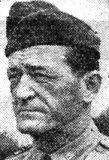
|
It was the longest aerial shipping attack in history, and is an example of the kind of aggressive support Nimitz can expect when the day comes for concerted action between the Navy he commands and the 14th Air Force.
40,000 TONS SUNK
Chennault wired back his thanks, adding that photographs of the action had since confirmed 40,000 tons of Jap shipping were sent to its watery grave in place of the original conservative estimate of 20,000 tons. "We hope," he replied, "to continue adding our bit to your great score until we meet in China."
During the week, P-40's of the Chinese-American Composite Wing of the 14th continued to hack away at Tojo's ships, attacking landing and supply barges along the Yangtze River between Itu and Shinchang.
JAPANESE KILLED
Many Japanese soldiers on one of the landing craft, which was damaged, were killed. Two 30-foot supply barges were severely strafed and a gasoline-loaded barge was set afire. Other P-40's strafed two 30-foot sail boats and many sampans.
At the same time, P-40's of the 14th, on a railroad sweep into French Indo-China strafed a locomotive and a number of freight cars near Bag Le, where they also set fire to a large supply building.
|
Beware of Miss Anopheles
There are 32 different kinds of females on the loose in the CBI Theater, an they're all named Anopheles.
Anopheles is a mosquito and she is willing to make a date with any soldier, particularly just after sunset or before dawn.
In order to dodge the passionate approach of Miss Mosquito, use your long clothing after dusk. G.I.'s look funny as hell in shorts anyway, to our way of thinking. You's never have the nerve to walk into your favorite bar back home with a pair of them on.
Use your repellent. It may not make you smell like a rose, but what's one odor more or less in this Theater?
Put down your mosquito net at night and tuck it in. Even if you're full of Fighter Brand whiskey, jingbaw juice or Indian gin, and imagine you are at home, don't forget to pull that net down, or when you get back to Shangri-La you'll wish you had.
For malaria is recurrent. If you get it over here, you may get it again in the States. And when you get a chill and flush in that rumble seat you can hardly tell your big moment, "It's malaria."
Maj. Frank A. Mantz, of the Theater Malaria office, is trying to push home the lesson of "Go Home Healthy." He's just back from a Theater tour and reports a great deal of interest among G.I.'s who plan soon to see Shangri-La under the rotation plan. He says a lot of them admit they have been lucky out here and that they didn't realize malaria was recurrent.
It takes about 12 days after you have been smitten by Anopheles' charms before the reaction sets in. Then you get a headache and a pain in the limbs. Even after you get into the hospital you'll generally experience two or three more chills.
From what we understand about these chills, they combine the feeling of a hangover and going without a drink for a month while working in a brewery.
The average "vacation" in the hospital is from eight to 12 days. Recovery amounts mostly to bunk fatigue, plus the taking of quinine and atabrine. It's not the best-tasting diet in the world.
So tuck in your nets, little lambs, and let the mosquitoes start biting on some Jap meat.
"Malaria," incidentally, comes from "mala" meaning bad, and "aria," meaning air. So just think of Frank Sinatra crooning and you've got it. This will probably no sooner hit the bushes than we will have some G.I. grammarian write in to say that mala doesn't mean bad and aria doesn't mean air. It's on page 605 of Webster's Collegiate Dictionary.
The C.B.I. Roundup is a weekly newspaper of the United States Army Forces, published by and for the men in China, Burma, and India, from news and pictures supplied by staff members, soldier correspondents, the United Press, OWI, and Army News Service. The Roundup is published Thursday of each week and is printed by The Statesman in New Delhi, India. Editorial matter should be sent directly to Capt. Floyd Walter, Headquarters, U.S.A.F., C.B.I., New Delhi, and should arrive not later than Sunday in order to make that week's issue. Pictures must arrive by Saturday and must be negatives or enlargements. Stories should contain full name and organization of sender.

MAY 18, 1944
Adapted from the original issue of C.B.I. Roundup
Similar, better quality image of Ava Gardner substituted for the original printed in the Roundup.
Copyright © 2007 Carl Warren Weidenburner
TOP OF PAGE PRINT THIS PAGE ABOUT THIS PAGE SEND COMMENTS
PREVIOUS ISSUE CLOSE THIS WINDOW NEXT ISSUE

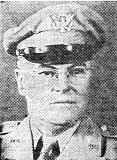
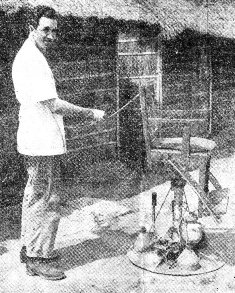

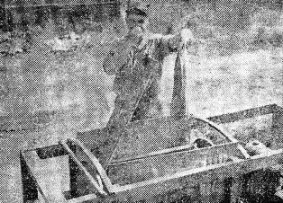
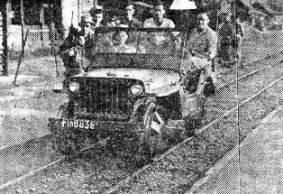 There's no limit to the uses to which the ubiquitous jeep has been put, and now here's another which would
probably make Casey Jones turn over in his grave. American railwaymen-soldiers ride a converted quarter-ton
along the Bengal and Assam Railroad on patrol duty.
There's no limit to the uses to which the ubiquitous jeep has been put, and now here's another which would
probably make Casey Jones turn over in his grave. American railwaymen-soldiers ride a converted quarter-ton
along the Bengal and Assam Railroad on patrol duty.
